Abstract
The antiprotozoal drug pentamidine [1,5-bis(4'-amidinophenoxy)pentane] has been previously shown to be metabolized by rat liver microsomes, and five of the seven putative primary metabolites have been identified. With the synthesis and identification of 5-(4'-amidinophenoxy)pentanoic acid and 5-(4'-amidinophenoxy)-1-pentanol as the remaining two metabolites, the primary metabolism of pentamidine in rats appears fully characterized. Use of [14C]pentamidine with rat liver microsomes confirms this conclusion, since no unidentified radioactive peaks were detected by high-performance liquid chromatography (HPLC). Isolated, perfused rat livers were used with [14C]pentamidine to identify secondary metabolites. Only two novel radioactive peaks were detected by HPLC analysis of perfused liver samples. The treatment of liver samples with sulfatase or beta-glucuronidase resulted in the reduction or elimination of these peaks and gave rise to peaks identified as para-hydroxybenzamidine and 5-(4'-amidinophenoxy)pentanoic acid. It was concluded from these results that only these two primary metabolites were conjugated with sulfate or glucuronic acid. After 4 h of incubation in the perfused liver system, approximately 15% of the recovered radiolabel was pentamidine. These results suggest that pentamidine metabolism can be rapid and extensive in rats.
Full text
PDF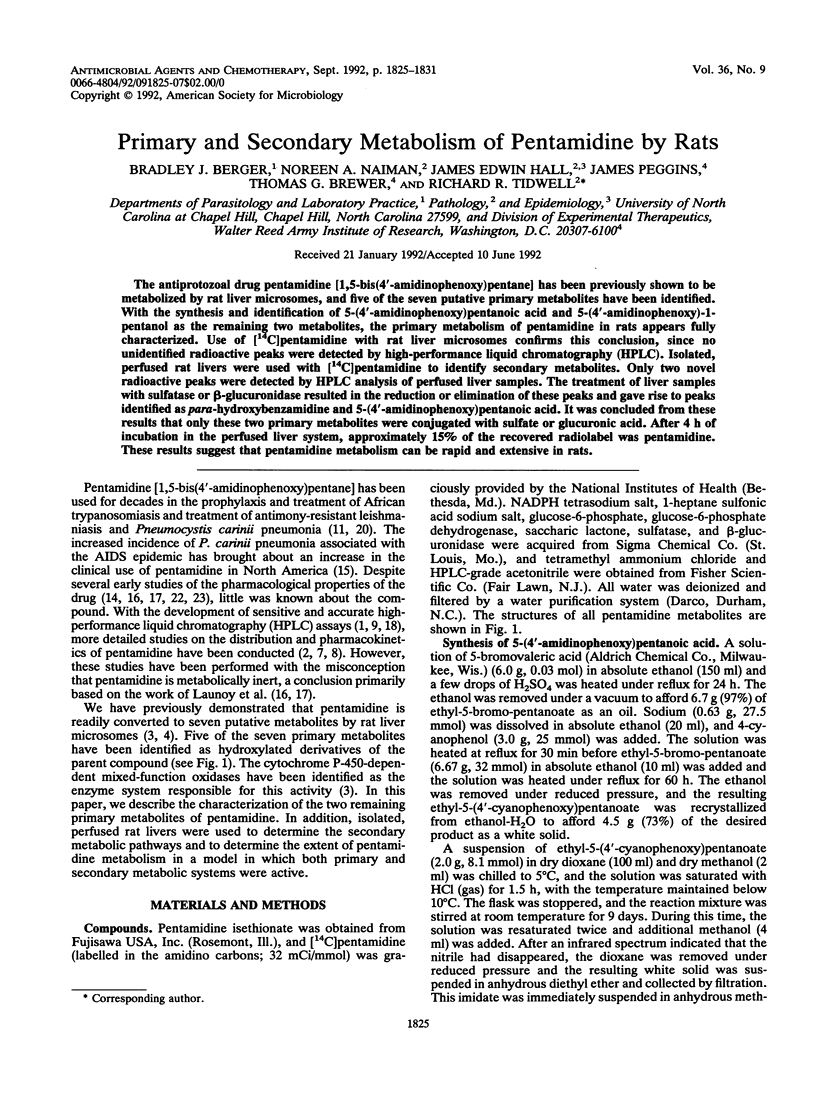
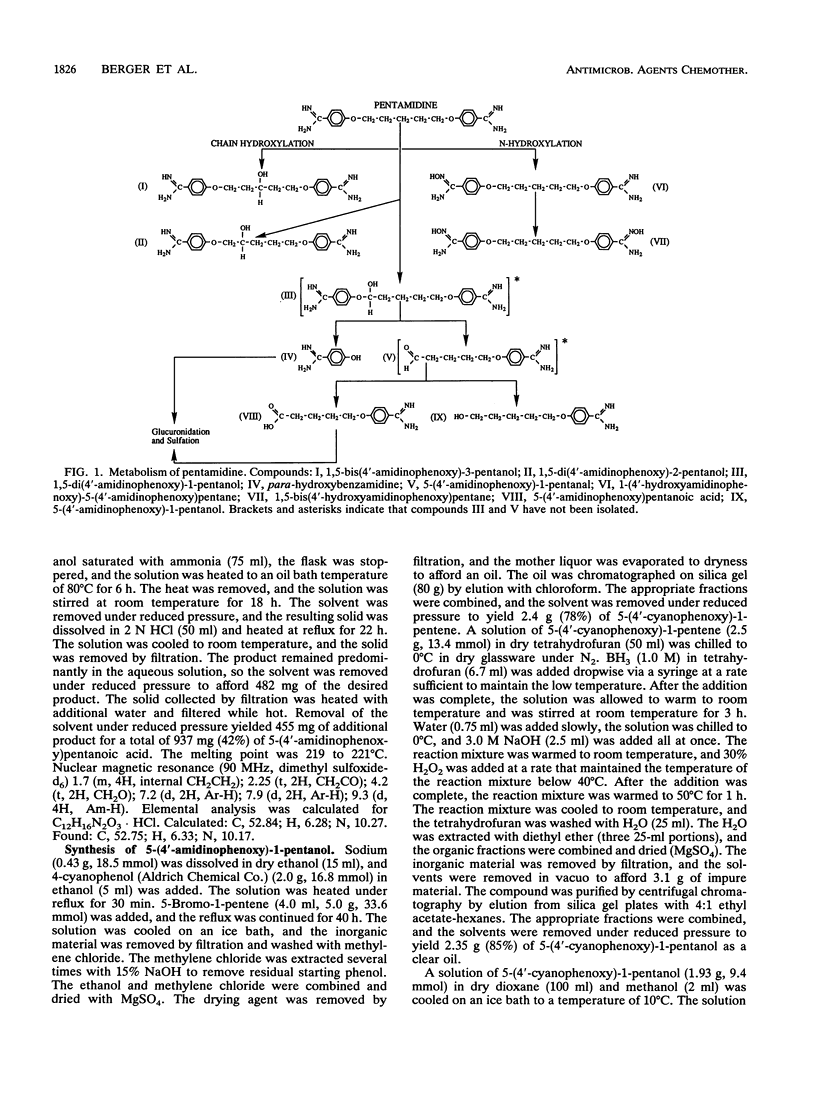
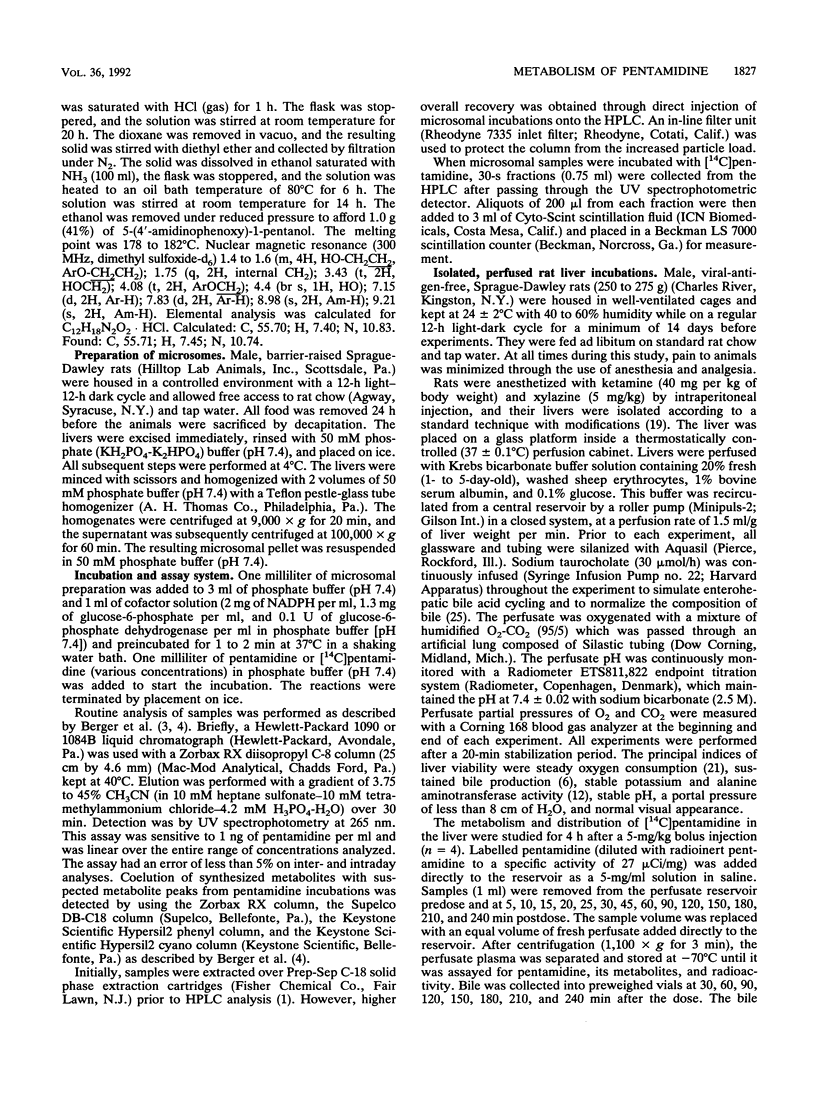
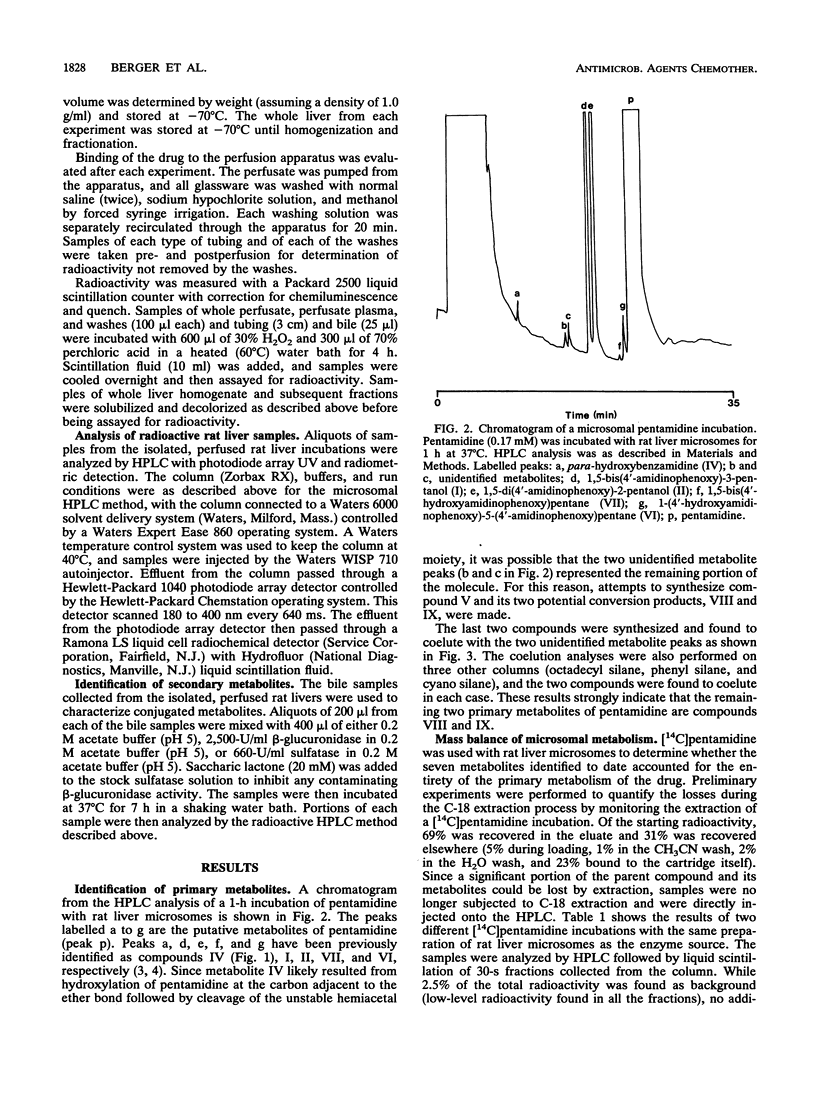

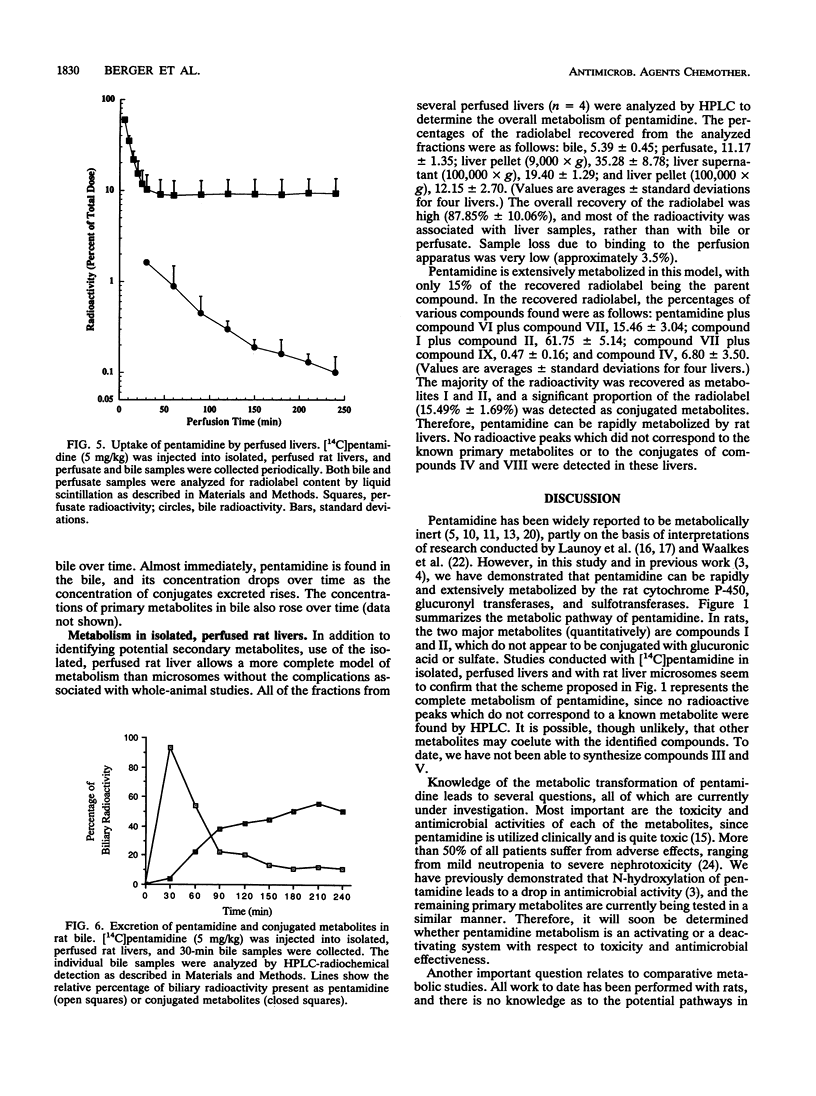
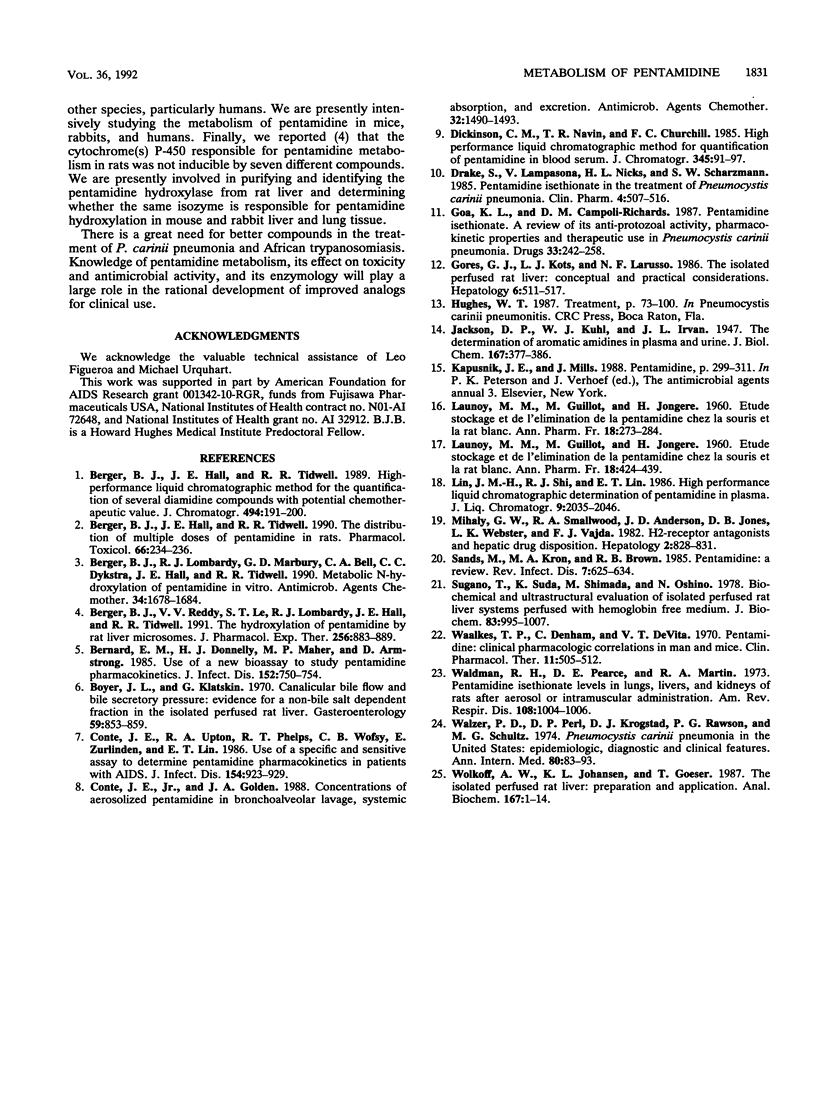
Selected References
These references are in PubMed. This may not be the complete list of references from this article.
- Berger B. J., Hall J. E., Tidwell R. R. High-performance liquid chromatographic method for the quantification of several diamidine compounds with potential chemotherapeutic value. J Chromatogr. 1989 Sep 29;494:191–200. doi: 10.1016/s0378-4347(00)82668-7. [DOI] [PubMed] [Google Scholar]
- Berger B. J., Hall J. E., Tidwell R. R. The distribution of multiple doses of pentamidine in rats. Pharmacol Toxicol. 1990 Mar;66(3):234–236. doi: 10.1111/j.1600-0773.1990.tb00740.x. [DOI] [PubMed] [Google Scholar]
- Berger B. J., Lombardy R. J., Marbury G. D., Bell C. A., Dykstra C. C., Hall J. E., Tidwell R. R. Metabolic N-hydroxylation of pentamidine in vitro. Antimicrob Agents Chemother. 1990 Sep;34(9):1678–1684. doi: 10.1128/aac.34.9.1678. [DOI] [PMC free article] [PubMed] [Google Scholar]
- Berger B. J., Reddy V. V., Le S. T., Lombardy R. J., Hall J. E., Tidwell R. R. Hydroxylation of pentamidine by rat liver microsomes. J Pharmacol Exp Ther. 1991 Mar;256(3):883–889. [PubMed] [Google Scholar]
- Bernard E. M., Donnelly H. J., Maher M. P., Armstrong D. Use of a new bioassay to study pentamidine pharmacokinetics. J Infect Dis. 1985 Oct;152(4):750–754. doi: 10.1093/infdis/152.4.750. [DOI] [PubMed] [Google Scholar]
- Boyer J. L., Klatskin G. Canalicular bile flow and bile secretory pressure. Evidence for a non-bile salt dependent fraction in the isolated perfused rat liver. Gastroenterology. 1970 Dec;59(6):853–859. [PubMed] [Google Scholar]
- Conte J. E., Jr, Golden J. A. Concentrations of aerosolized pentamidine in bronchoalveolar lavage, systemic absorption, and excretion. Antimicrob Agents Chemother. 1988 Oct;32(10):1490–1493. doi: 10.1128/aac.32.10.1490. [DOI] [PMC free article] [PubMed] [Google Scholar]
- Conte J. E., Jr, Upton R. A., Phelps R. T., Wofsy C. B., Zurlinden E., Lin E. T. Use of a specific and sensitive assay to determine pentamidine pharmacokinetics in patients with AIDS. J Infect Dis. 1986 Dec;154(6):923–929. doi: 10.1093/infdis/154.6.923. [DOI] [PubMed] [Google Scholar]
- Dickinson C. M., Navin T. R., Churchill F. C. High-performance liquid chromatographic method for quantitation of pentamidine in blood serum. J Chromatogr. 1985 Nov 29;345(1):91–97. doi: 10.1016/0378-4347(85)80138-9. [DOI] [PubMed] [Google Scholar]
- Drake S., Lampasona V., Nicks H. L., Schwarzmann S. W. Pentamidine isethionate in the treatment of Pneumocystis carinii pneumonia. Clin Pharm. 1985 Sep-Oct;4(5):507–516. [PubMed] [Google Scholar]
- Goa K. L., Campoli-Richards D. M. Pentamidine isethionate. A review of its antiprotozoal activity, pharmacokinetic properties and therapeutic use in Pneumocystis carinii pneumonia. Drugs. 1987 Mar;33(3):242–258. doi: 10.2165/00003495-198733030-00002. [DOI] [PubMed] [Google Scholar]
- Gores G. J., Kost L. J., LaRusso N. F. The isolated perfused rat liver: conceptual and practical considerations. Hepatology. 1986 May-Jun;6(3):511–517. doi: 10.1002/hep.1840060331. [DOI] [PubMed] [Google Scholar]
- LAUNOY L., GUILLOT M., JONCHERE H. [Study of the accumulation and the elimination of pentamidine in the mouse and the white rat]. Ann Pharm Fr. 1960 Jun;18:424–439. [PubMed] [Google Scholar]
- LAUNOY L., GUILLOT M., JONCHERE H. [Study of the storage and elimination of pentamidine in the mouse and white rat]. Ann Pharm Fr. 1960 May;18:273–284. [PubMed] [Google Scholar]
- Mihaly G. W., Smallwood R. A., Anderson J. D., Jones D. B., Webster L. K., Vajda F. J. H2-receptor antagonists and hepatic drug disposition. Hepatology. 1982 Nov-Dec;2(6):828–831. doi: 10.1002/hep.1840020615. [DOI] [PubMed] [Google Scholar]
- Sands M., Kron M. A., Brown R. B. Pentamidine: a review. Rev Infect Dis. 1985 Sep-Oct;7(5):625–634. doi: 10.1093/clinids/7.5.625. [DOI] [PubMed] [Google Scholar]
- Sugano T., Suda K., Shimada M., Oshino N. Biochemical and ultrastructural evaluation of isolated rat liver systems perfused with a hemoglobin-free medium. J Biochem. 1978 Apr;83(4):995–1007. doi: 10.1093/oxfordjournals.jbchem.a132028. [DOI] [PubMed] [Google Scholar]
- Waalkes T. P., Denham C., DeVita V. T. Pentamidine: clinical pharmacologic correlations in man and mice. Clin Pharmacol Ther. 1970 Jul-Aug;11(4):505–512. doi: 10.1002/cpt1970114505. [DOI] [PubMed] [Google Scholar]
- Waldman R. H., Pearce D. E., Martin R. A. Pentamidine isothionate levels in lungs, livers, and kidneys of rats after aerosol or intramuscular administration. Am Rev Respir Dis. 1973 Oct;108(4):1004–1006. doi: 10.1164/arrd.1973.108.4.1004. [DOI] [PubMed] [Google Scholar]
- Walzer P. D., Perl D. P., Krogstad D. J., Rawson P. G., Schultz M. G. Pneumocystis carinii pneumonia in the United States. Epidemiologic, diagnostic, and clinical features. Ann Intern Med. 1974 Jan;80(1):83–93. doi: 10.7326/0003-4819-80-1-83. [DOI] [PubMed] [Google Scholar]
- Wolkoff A. W., Johansen K. L., Goeser T. The isolated perfused rat liver: preparation and application. Anal Biochem. 1987 Nov 15;167(1):1–14. doi: 10.1016/0003-2697(87)90127-8. [DOI] [PubMed] [Google Scholar]


